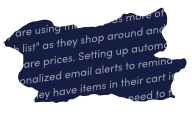A/B testing is a common tool used in digital marketing to test two versions of a digital ad or asset and find out which performs better. The test usually involves one element, such as two different versions of a headline, or two different colors on the CTA button. The purpose of an A/B test is to find out which version garners more interest and engagement among the target audience. Marketers can use that information to optimize online campaigns and boost performance.
What is A/B testing?
A/B testing, also known as split testing, bucket testing, or split-run testing, is a type of experiment where two samples are compared. Each sample is the same; save one element. In digital marketing, this could be the call-to-action, image, headline, email subject line, or many other elements. Whichever version sees more user engagement is the preferred option. The knowledge gained from A/B testing is vital to help marketers optimize their online ads, email campaigns, or landing pages, so they can continually get better results.
What is the purpose of A/B testing?
The purpose of A/B testing is to determine which variation in an ad, email, or other digital asset is more successful in achieving the set goal or KPI, such as click-through rate, conversion rate, or revenue. By randomly assigning users to either the control group or the test group, and measuring the difference in results between the two groups, marketers can make data-driven decisions to optimize their marketing efforts and improve their overall performance. A/B testing is an essential tool for digital marketers looking to increase their ROI and improve the user experience for their audience.
How to do A/B testing
To conduct A/B testing for a digital campaign, follow these steps:
- Define your objective: Identify the specific goal you want to achieve through A/B testing, such as increasing click-through rate or improving conversion rate.
- Create variations: Develop two versions of the campaign element you want to test, such as two different email subject lines or two different versions of a landing page.
- Choose a sample size: Determine the number of users you want to include in the test group and the control group. A larger sample size will produce more accurate results but may require more time and resources.
- Randomly assign users: Divide the sample group into two random groups: the control group and the test group.
- Run the test: Launch both versions of the campaign element to the respective groups and measure the results. Use analytics tools to track metrics such as click-through rate, conversion rate, and revenue.
- Analyze the results: Determine which version of the campaign element performed better and achieved the objective set in step 1.
- Implement the winner: Implement the winning version of the campaign element in your digital marketing strategy.
- Repeat the process: Continue to test and optimize your digital campaigns through A/B testing to continuously improve your marketing performance.
Benefits of A/B testing
A/B testing provides several benefits in digital marketing, including:
- Data-driven decisions: A/B testing allows marketers to make data-driven decisions based on actual user behavior and preferences, rather than relying on assumptions.
- Improved conversion rates: By testing different versions of campaign elements, marketers can identify the most effective design, messaging, or layout to increase conversions.
- Increased ROI: Optimizing campaigns through A/B testing can result in increased revenue and a higher return on investment for marketing efforts.
- Better user experience: A/B testing helps marketers understand what resonates with their audience, enabling them to create a better user experience that drives engagement and loyalty.
A/B testing tools: an overview
When looking for an A/B testing tool, there are a few things to consider.
- Ease of use: How complicated is the tool? Does it require coding or statistical knowledge? Is your marketing team prepared to handle the software? Do they require additional training to use it?
- Targeting: Can the tool target your audience? How does it identify audience segments? This is especially important if your A/B test looks at how a single sample performs with two separate sets of users.
- Integrations: Does the tool integrate with your company’s existing software? Will you need additional software to utilize the data collected? How easily can you migrate your data between the tool and other software? Will you need an expert to perform the migrations for you?
- Testing factors: How complex are your tests? Can the tool handle server-side testing and code changes? Does it only work with client-side testing (differing calls-to-action, page layout, etc.)?
Free A/B Testing Tools
If you’re looking for A/B testing tools that won’t break the budget while still providing valuable insights and results, take a look at these:
HubSpot & Kissmetrics A/B Testing Kit
Kissmetrics’ testing kit uses deep tracking to provide useful insights about customer bases and their ensuing choices. Although it isn’t suited for enterprise businesses, it works exceptionally well for SMBs, especially those with a tight marketing budget. It’s a flexible system, though that flexibility can be a potential pitfall since it makes for a somewhat complicated interface.
GrowthBook
This open-source platform is an excellent tool for measuring performance and reporting significance. It integrates with the majority of SQL tools and Google Analytics. GrowthBook is highly adaptable and well-suited for a variety of needs. One of the best parts is that GrowthBook will automatically alert you if a decision or feature may harm your metrics. You can choose to shut it down quickly with a killswitch.
Optimizely
One of the best aspects of Optimizely is its ease of use. Setting up the system is a breeze, and operating it takes common sense, not years of coding experience. The downside is that Optimizely has few choices to track a sample’s success. However, for many marketing teams, clicks and page views are the most important success markers.
Plus, Optimizely tracks based on unique visitors, so you know your information is more accurate than session-based trackers. It’s specifically designed for websites with high traffic levels.
Paid A/B Testing Tools
If your business has the budget for an A/B testing tool, check out these options:
Mutiny
Mutiny was designed for B2B companies and lets you target specific audience segments. Once you’ve designated your audience targets, Mutiny makes it easy to run A/B tests between the segments. It integrates with Salesforce CRM and provides suggestions for defining audience segments. Mutiny even uses AI suggestions to help you get the most out of your content.
Plus, it has a visual editor that allows for plenty of changes without coding knowledge. Mutiny prides itself on being a code-free platform, so marketing teams can execute everything in just a few minutes. On average, Mutiny costs around $24,000 a year.
VWO (Visual Website Optimizer)
Visual Website Optimizer, or VWO, is quite popular for businesses with smaller marketing budgets that want big results. It has plenty of other tools besides A/B testing and tracks conversion goals well. It automatically provides statistical analyses of your results to see whether the differences are statistically significant.
With a friendly UX and easy set-up, creating and running new tests is simple. VWO is somewhat cheaper at about $24,000 per year.
Kameloon
Kameloon is one of the most popular choices for healthcare and financial businesses because of its tight focus on safety and privacy. It has integrations with Shopify and Git, as well as a Google Chrome extension. It works well for server and client-side testing and is a powerful tool with many opportunities for customization.
It’s a little expensive at approximately $30,000 annually, but many companies find Kameloon well worth the cost, knowing that their user base’s privacy is intact.
A/B testing examples
A/B testing is often used to test email campaigns. For example, you’ve noticed that emails sent on a specific day of the week tend to get more engagement, but you want to optimize your open rate even more by testing your send time. An A/B test is the perfect way to measure whether users are likelier to click your link on emails sent in the morning or afternoon.
Another example where A/B testing is critical is ad headlines. Ads have very little time to capture a user’s attention, just seconds! Your headlines need to compete with all the other content on a webpage and entice a reader to click your link. You might have two great options, one using negative keywords and one using positive ones, but seeing how your target audience reacts to them is the best way to choose.


